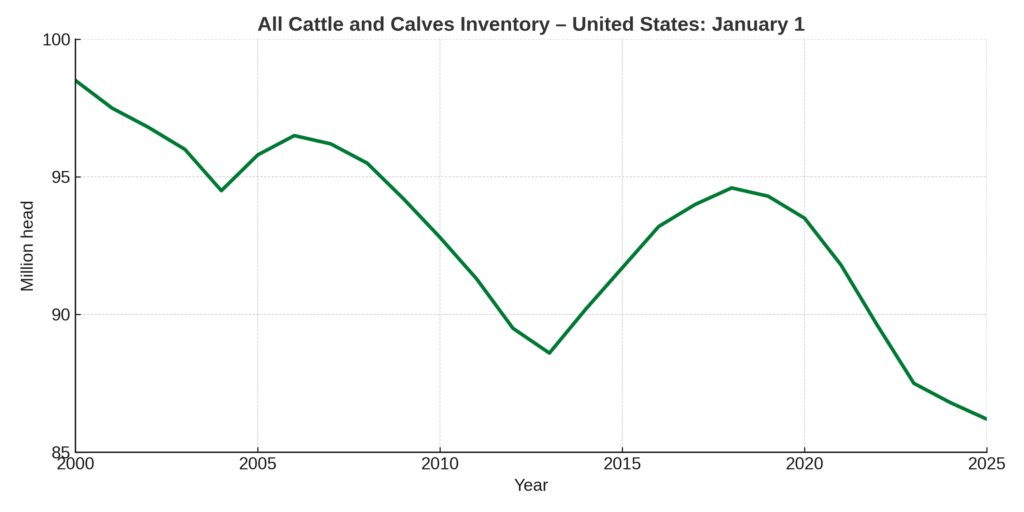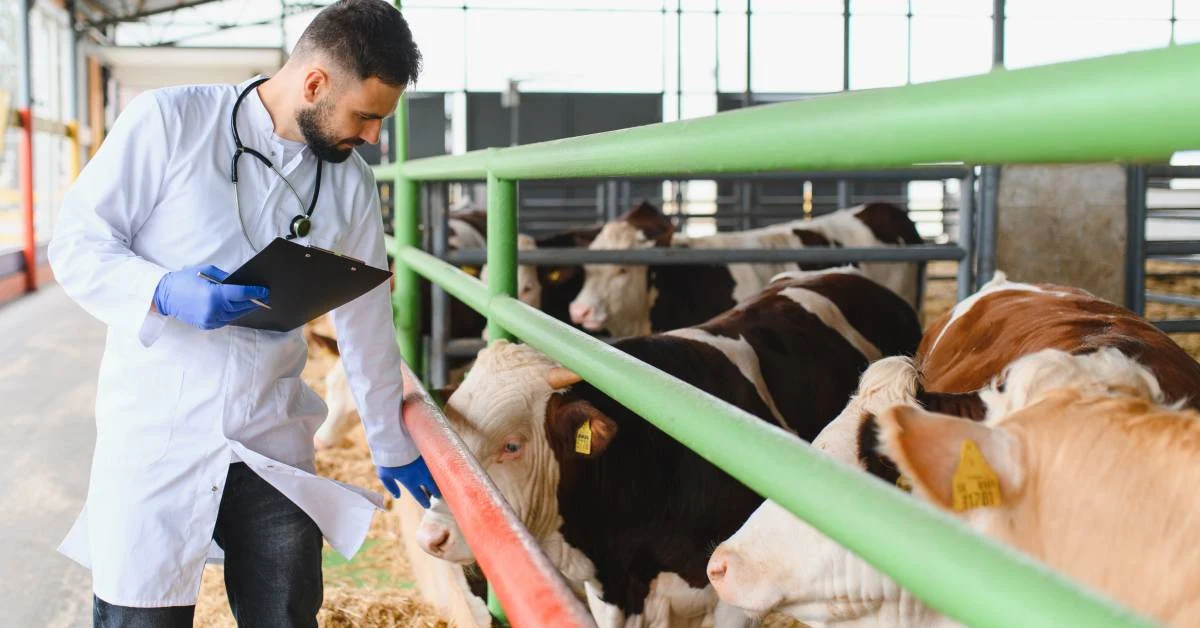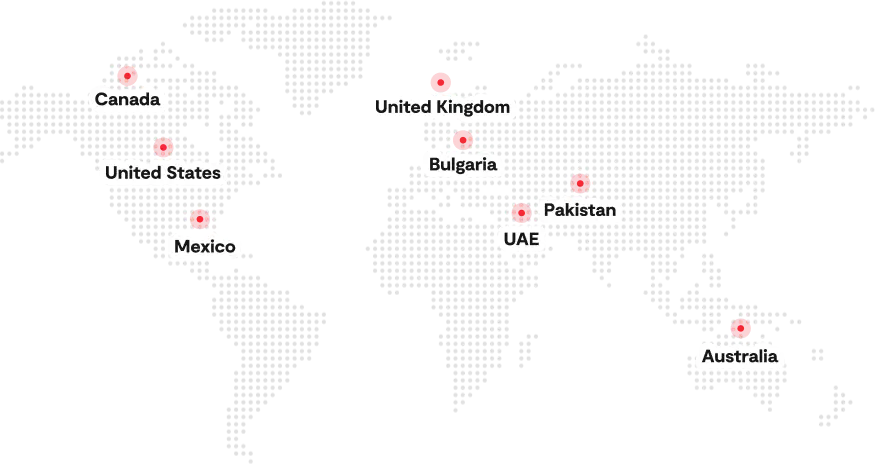Livestock procurement has always required a sharp eye and solid instincts. But in 2025, those alone aren’t enough. With national cattle inventories hitting a 70-year low, down to 86.7 million head, according to the USDA’s January 2025 Cattle Report, tight supply and firm prices are the new normal. That shift is forcing feedlots and buyers to revisit how, when, and from whom they handle cattle procurement.
Margins are under pressure not just from the front-end cost of animals, but from everything that follows: ration planning, animal performance, contract terms, and even how well purchase data integrates into feedlot systems. Optimizing livestock procurement today means more than negotiating a good price; it’s about building better procurement intelligence across the board.
This article explores what that looks like in practice: smarter sourcing strategies, improved forecasting, technology that connects procurement to performance, and operational changes that give buyers more control in a volatile market.

Understanding Livestock Procurement in 2025
The Evolving Landscape of Cattle Purchasing
Cattle procurement in 2025 is being shaped by far more than supply and demand. Today’s buying decisions are affected by operational risks, cost structure shifts, and the increasing demand for precision throughout the value chain. Feedlot operators and procurement leads are being forced to scrutinize every aspect of how they purchase livestock to find better prices and avoid cost overruns hidden in the details.
Key Factors Influencing Procurement Costs
Procurement costs are no longer defined solely by the price per head. They are shaped by a mix of operational, biological, and market-specific variables, many of which buyers are now expected to monitor and manage in real time.
Below are the factors that are really driving up costs in livestock procurement today:
1. Feed and Market-Driven Sourcing Costs
Feed remains the largest cost component in beef production, and it directly influences what sellers charge for feeder or backgrounded cattle. Even with corn and soybean meal softening slightly in 2025, input prices still vary regionally and are affected by weather, exports, and fuel.
- Rising feed input costs (including corn, soybean meal, and forage) are often passed to buyers at higher animal prices.
- Freight costs, driven by diesel prices and limited transport capacity, continue to increase the per-head cost, especially when sourcing from distant suppliers.
- Market volatility means operators buying without a plan often face peak-season pricing or reactive purchases that cost more than expected.
The bottom line is that if you don’t factor in your purchases’ logistics cost and market timing, you’re likely overpaying before cattle even hit your pens.
2. Animal-Related Risk Factors
Not all cattle deliver the same performance, and inconsistent lots can quietly erode feedlot profitability. More procurement teams are realizing that what looks like a good price upfront may turn into a higher cost-per-gain over time.
- Genetic inconsistency affects uniformity, daily gain, and feed efficiency. Mixed lots often require more sorting, longer days on feed, and more ration adjustments.
- Lack of preconditioning or missing health protocols increases the risk of respiratory disease and treatment costs. High-risk cattle often require more labor, medication, and downtime.
- An unknown backgrounding history makes it difficult to predict performance and may lead to surprises during transition or finishing.
Purchasing livestock without reliable background and health data often means absorbing costs later in the feeding cycle, whether through slower gains or higher pull rates.
3. Internal Procurement Inefficiencies
Many feedlots still rely on outdated procurement methods, such as manual tracking, reactive calls to sellers, and little connection between procurement and performance data. These inefficiencies compound over time.
- Poor procurement planning leads to rushed buying at inopportune times, missed pricing opportunities, or inconsistent supply.
- Lack of supplier tracking means decisions are often based on gut feeling, not data.
- Disconnected systems between procurement, feedlot ops, and finance result in delays, mismatched information, and difficulty benchmarking true cost per head.
Procuring without structure or digital cattle record keeping limits a feedlot’s ability to scale, negotiate, or improve over time.
4. Compliance, Documentation, and Operational Overhead
Today, procurement isn’t just about selecting animals; it’s also about managing paperwork, audits, and certifications that are becoming standard across the beef supply chain.
- Traceability requirements mean buyers must collect and store animal source, treatment records, and health data.
- Third-party certifications like NHTC, GAP, or Verified Natural Beef come with added costs but are often required for certain markets.
- Labor time spent on compliance tasks, logistics coordination, and record maintenance is a growing overhead many operators don’t fully track.
These are real costs, especially as procurement scales. Feedlots managing large volumes without a centralized feedlot management system often spend more on just staying compliant.
In short, optimizing livestock procurement today means understanding where hidden costs originate and building processes to control them. The more structured your procurement system, the less you lose to variability, inefficiency, or missed opportunities.
How to Optimize Cattle Procurement Processes and Purchasing Costs
Reducing cattle purchasing costs doesn’t just come from negotiating a better price per head. It requires a more structured, data-informed livestock procurement process that eliminates waste, avoids last-minute buying risks, and improves predictability at every step.
Here’s how top-performing operations are building smarter procurement systems that directly reduce costs while improving quality and consistency.
1. Align Procurement With Cost and Performance Objectives
Every lot of cattle you buy impacts the total cost of gain, labor demand, and finishing timelines. Strategic procurement begins by aligning your buying criteria with operational goals, whether that’s reducing feed-to-gain cost, minimizing variability, or meeting packer specs more efficiently.
Feedlots with a cost-control focus buy based on conversion potential, not just initial weight or genetics. They look at how each purchase impacts overall throughput and ration efficiency. By defining the ideal cattle profile for your system and sticking to it, you avoid the hidden costs of mismatched animals, inconsistent gain, or extended days on feed.
2. Evaluate Suppliers Based on Cost-Impact, Not Just Trust
Long-term supplier relationships matter, but relying solely on trust or habit can lead to untracked losses. A strategic procurement system ranks suppliers not just by delivery history, but also by cost and performance outcomes.
Key metrics include treatment rate, shrink, average daily gain, uniformity, and carcass consistency. Operations using structured evaluations identify which sellers consistently deliver value, and which quietly add to costs through post-arrival health issues or underperformance.
Tools like farm record-keeping software help centralize this data, giving procurement managers visibility across lots, timelines, and supplier behavior. This insight leads to smarter negotiations and more confident, cost-driven decisions.
3. Plan Purchases to Avoid Costly Timing Mistakes
One of the biggest drivers of excessive cattle costs is poor timing. Waiting too long to secure cattle or buying based on immediate need almost always leads to overpaying. Feedlots that plan ahead avoid bidding into price spikes or scrambling for supply during tight markets.
Strategic teams use procurement calendars aligned with feeding space, expected harvest dates, and local market trends. They also build sourcing flexibility by contracting part of their needs early, while leaving room to buy opportunistically.
This forward-looking approach reduces procurement gaps and stabilizes landed costs over time, a key advantage in volatile cattle markets.
4. Use Digital Systems to Track True Procurement Cost
Without accurate cost tracking across freight, treatments, labor, and feed conversion, controlling procurement expenses is nearly impossible. Feedlots investing in digital tools like cattle feeding software are gaining visibility into real cost per head, from purchase to close out.
By connecting procurement decisions with post-arrival performance, feedlots can identify what kinds of cattle and suppliers deliver the best ROI. Systems like farm data management software provide centralized control over lot tracking, supplier history, health data, and financials.
This level of insight helps buyers avoid guesswork, justify purchasing choices with data, and optimize sourcing to minimize waste.
5. Strategic Procurement for Higher Predictability
A reactive procurement process leads to unexpected costs, higher treatment rates, poor bunk management, or uneven weight gain. A strategic livestock procurement process reverses this by giving operators control over the variables that quietly erode margin.
Livestock procurement is shifting from a transactional role to a strategic, performance-driven function as industry pressures grow. Operations that build structured, forward-looking systems are already seeing the cost-control benefits and setting themselves up to compete in a tighter, faster market.
Role of Feedlot Procurement Software in Livestock Purchasing
Once a feedlot reaches the scale where procurement decisions directly impact performance and profit, managing livestock purchases with spreadsheets or notebooks simply doesn’t cut it. This is where feedlot procurement software becomes a cost-control asset, not just a convenience.
Modern livestock procurement tools are designed to give feedlot managers and buyers real-time visibility into sourcing activity, contract terms, cattle status, and supplier performance, all in one place. The right software streamlines the buying process and helps reduce procurement-related losses by improving accuracy, accountability, and timing.
Here’s how software purpose-built for livestock procurement helps feedlots control cost:
Supplier Management with Performance History
The software lets you maintain detailed supplier profiles, including delivery records, treatment rates, and contract terms. This allows procurement teams to prioritize vendors who meet spec, deliver on time, and don’t cost you extra on the back end.
Contract & Compliance Control
Every purchase contract and vendor SLA can be tracked in one place, complete with alerts for delivery deadlines and compliance checkpoints. For feedlots managing USDA programs or packer-specific requirements, built-in compliance workflows make audits faster and reduce manual overhead.
Inventory-Linked Ordering
Instead of guessing when to reorder, the system links directly to pen-level inventory and feed consumption. When levels drop below a set threshold, it can trigger a requisition, cutting down on emergency buys, late loads, or overstocking.
Spend Analysis by Category
With built-in spend tracking, buyers and managers can see where procurement dollars are going, feed, medication, or cattle lots. This helps identify patterns, flag cost overruns early, and support better vendor negotiations over time.
Multi-Yard Procurement Visibility
The software offers centralized visibility for operations with more than one site. You can consolidate purchasing activity across locations, align delivery schedules, and even negotiate better pricing on volume-based cattle contracts.
Batch-Level Receiving & Invoice Matching
Every cattle lot or feed order can be tied to a batch number and timestamp, so you know exactly what arrived, when, and where. Invoices are matched automatically to purchase orders, and discrepancies are flagged before approval, tightening controls and reducing payment errors.
A modern livestock procurement platform gives feedlots more than efficiency; it gives them leverage. When every contract, supplier, and order is part of a single, traceable system, the result is fewer delays, tighter cost control, and better long-term decision-making.
Conclusion
The pressure on feedlot margins isn’t easing, but where that pressure is coming from has shifted. It’s not just input costs or market volatility, it’s the quiet, cumulative impact of how livestock procurement is handled day to day.
When cattle buying is treated as a routine task, costs get buried in freight overruns, inconsistent performance, and reactive sourcing. But when procurement becomes a structured, data-led process, the results show up across the entire yard, from more predictable feed conversion to tighter control over spend.
This shift isn’t about adopting more tech for the sake of it. It’s about taking full ownership of a process that directly affects profitability. And in 2025, livestock procurement isn’t just one piece of the operation; it’s the one that can widen or close your margin faster than almost anything else.
FAQs
How Can Feedlot Procurement Software Help In Managing Cattle Purchasing Costs?
Feedlot procurement software reduces cattle purchasing costs by improving planning, supplier accountability, and real-time decision-making. It allows feedlots to track supplier performance, automate contract and invoice management, and prevent overbuying through inventory-linked ordering. These tools help buyers make more informed, cost-efficient decisions across every lot purchased.
What Are The Key Features To Look For In Livestock Procurement Software?
The most important features in livestock procurement software include supplier performance tracking, contract management, inventory-linked ordering, automated invoicing, and multi-site purchasing visibility. These tools help feedlots manage costs, maintain traceability, and stay compliant. Some platforms also integrate with USDA compliance systems to simplify reporting and audit readiness.
What Are The Benefits Of Using Digital Procurement Solutions In Livestock Operations?
Digital procurement solutions bring better control, cost transparency, and consistency to livestock operations. Benefits include reduced paperwork, centralized supplier data, faster approvals, real-time cost tracking, and stronger contract compliance. They also improve inventory coordination and help reduce overspending by automating order triggers based on actual usage.
How Can AI And Machine Learning Enhance Livestock Procurement Strategies?
AI and machine learning optimize livestock procurement by predicting market trends, identifying supplier risk patterns, and recommending cost-efficient sourcing decisions. These technologies analyze large datasets, like historical performance, health outcomes, and pricing, to help feedlots make faster, smarter purchasing choices. When combined with technologies like computer vision in agriculture, they also enhance livestock evaluation and grading at scale.







